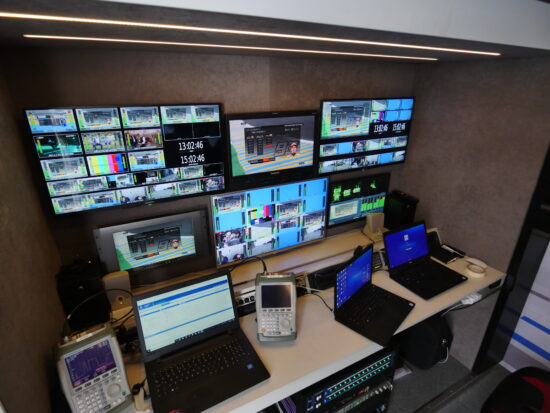Tata Communications’ Mehul Kapadia highlights the impact technological advancements have on fan experience.
Sport, especially cricket, unites a nation like India. Cricket has over one billion fans globally and more than 90% of them are from the Indian sub-continent alone. With the ongoing IPL 2019 and the World Cup 2019 now, ‘Cricket’ is the language India is speaking right now. Cricket fans, no matter where they are, are demanding a first-hand, up close and immersive experience of the intense field action.
 To cater to this, sports companies, association bodies, broadcasters, brands and marketers have all come together to provide a best-in-class and more recently, tailor-made entertainment experience to a growing fan base, globally – and technology is at the heart of this evolving fan experience and the high ROI brands witness.
To cater to this, sports companies, association bodies, broadcasters, brands and marketers have all come together to provide a best-in-class and more recently, tailor-made entertainment experience to a growing fan base, globally – and technology is at the heart of this evolving fan experience and the high ROI brands witness.
Robust tech infrastructure and delivery chain have enabled video streaming platforms to bring live sports to viewers, wherever they are. Broadcasters have also realised that cricket is a game of sentiments for Indians, and if the action is narrated in the viewers’ own language, it brings them closer to the game.
“Last year, IPL commentary expanded to eight regional languages with more added this season. The result? IPL 2018 on a video-streaming platform alone attracted over 202 million viewers which was an increase of 55.3% from 2017 and this year, it has already achieved a record 267 million viewers within the first three weeks.”
Technology has played a pivotal role here. That same year, IPL was enabled remote production technology which offered this multi-language experience and centralised much of the core operations, managing them remotely from a single production hub. Remote production technology ensures smooth transmission of a combination of signals and multiple HD feeds straight from the cameras at the cricket stadium to the hub and then the viewer.
 For broadcasters, remote production is a big win in terms of costs, resource management, and handling complex logistics. They have effectively managed to leverage the best that technology has to offer when it comes to network connectivity, cloud infrastructure, content delivery, security, etc. managing a seamless experience starting from the multiple on-field HD cameras and straight to the high-resolution screens viewed by fans, letting tech companies manage the entire chain in between.
For broadcasters, remote production is a big win in terms of costs, resource management, and handling complex logistics. They have effectively managed to leverage the best that technology has to offer when it comes to network connectivity, cloud infrastructure, content delivery, security, etc. managing a seamless experience starting from the multiple on-field HD cameras and straight to the high-resolution screens viewed by fans, letting tech companies manage the entire chain in between.
Technology has enabled an upsurge in fantasy sports platforms, as well.
“A fan experience starts way before the game has begun and this is where immersive technology comes into play.”
The popularity of fantasy sports apps is a testament to how digitisation can be used to optimise fan behaviour and skills to literally get them into the game. Ardent fans have opinions and predictions from the time of selection to the final whistle on the field. Fantasy sports platforms are brilliantly leveraging this behaviour. Fans can now create their own teams, predict games by betting on them and winning prizes and money that can even be directly transferred to their bank accounts. Fan adoption of such platforms has been so good that we recently witnessed a first Indian gaming company enter the ‘unicorn club.’
“Marketers are also realising that these digital platforms are where fans are consuming content. They’re finding ways to feature their products without interfering in the viewer’s experience.”
 Clearly, there is a lot happening when it comes to leveraging technology for fan engagement. Yet, India has barely scratched the surface of digitisation in the sports arena; a sector which is projected to hit USD $31.1 billion by 2024. Globally, the fan experience is being augmented in several ways with continuous innovation. From streaming games in virtual reality (VR) to building smart stadiums that offer intelligent automation technology reducing operational costs, there is no stopping a world-class immersive fan experience. For instance, the 2017 F1 Grand Prix had a 360-degree live video concept trial which put viewers at the heart of the action, empowering them to choose how they want to watch and engage with F1. The 2018 FIFA World Cup which a Video Assistant Referee (VAR) assessing every goal or a potential penalty, without impacting the live drama.
Clearly, there is a lot happening when it comes to leveraging technology for fan engagement. Yet, India has barely scratched the surface of digitisation in the sports arena; a sector which is projected to hit USD $31.1 billion by 2024. Globally, the fan experience is being augmented in several ways with continuous innovation. From streaming games in virtual reality (VR) to building smart stadiums that offer intelligent automation technology reducing operational costs, there is no stopping a world-class immersive fan experience. For instance, the 2017 F1 Grand Prix had a 360-degree live video concept trial which put viewers at the heart of the action, empowering them to choose how they want to watch and engage with F1. The 2018 FIFA World Cup which a Video Assistant Referee (VAR) assessing every goal or a potential penalty, without impacting the live drama.
The next leap for India is the adoption of these new immersive technologies such as AR, VR and IoT, which will revamp and remodel the way fans interact, creating that special ‘all-access pass’ experience which is priceless to any fan – not just with the game, but with the teams, players and brand sponsors, too.
From the ability to watch game replays, to travel partners offering convenient transportation and parking, to food partners taking orders while watching the game and serving them hot at your seat, and even winning prizes through activations; fan engagement has seen a new innings with a lot more to come, as we embrace newer disruptive technologies.
“After all, sports is no longer just a game, it is an entire entertainment package.”
Is there more to technology in sports entertainment? Read our previous blog on what tech brings to the Cricket World Cup.
Tata Communications was the Official Connectivity Provider of Formula 1® between 2012 and 2019. Tata Communications was also the Official Managed Connectivity Supplier to Mercedes-AMG Petronas Motorsport, and Official Digital Transformation Partner to ROKiT Williams Racing until the end of the 2019 season.
Transformational Hybrid SolutionsOur cloud-enablement services offer the best performance on your traffic-heavy websites or mission-critical applications.
Core NetworksTata Communications™ global IT infrastructure and fibre network delivers the resources you need, when and where you need them.
Network Resources
Unified Communications As A ServiceBreak the barriers of borders efficiently and increase productivity with Tata Communications’ UC&C solutions.
Global SIP ConnectEmpower your business with our SIP network and witness it grow exponentially.
InstaCC™ - Contact Centre As A ServiceCloud contact centre solutions for digital customers experience and agent productivity.
Unified Communication Resources Case studies, industry papers and other interesting content to help you explore our unified communications solution better.
IoT SolutionsThe Internet of Things is transforming the way we experience the world around us for good. Find out more about our Internet Of Things related solutions here.
Mobility SolutionsTata Communications’ mobility services enable your enterprise to maintain seamless communication across borders, with complete visibility of cost and usage.
Mobility & IoT Resources
Multi-Cloud SolutionsWith enterprises transitioning to a hybrid multi-cloud infrastructure, getting the right deployment model that yields ROI can be a daunting task.
Cloud ComplianceCompliant with data privacy standards across different countries and is also designed to protect customers’ privacy at all levels.
IZO™ Cloud Platform & ServicesIZO™ is a flexible, one-stop cloud enablement platform designed to help you navigate complexity for more agile business performance.
Managed Infrastructure ServicesIntegrated with our integrated Tier-1 network to help your business grow efficiently across borders.
Cloud PartnersWe support a global ecosystem for seamless, secure connectivity to multiple solutions through a single provider.
Cloud Resources
Governance, Risk, and ComplianceRisk and Threat management services to reduce security thefts across your business and improve overall efficiencies and costs.
Cloud SecurityBest-in-class security by our global secure web gateway helps provide visibility and control of users inside and outside the office.
Threat Management - SOCIndustry-leading threat-management service to minimise risk, with an efficient global solution against emerging security breaches and attacks.
Advanced Network SecurityManaged security services for a predictive and proactive range of solutions, driving visibility and context to prevent attacks.
Cyber Security ResourcesCase studies, industry papers and other interesting content to help you explore our securtiy solution better.
Hosted & Managed ServicesTata Communications provide new models for efficient wholesale carrier voice service management. With our managed hosting services make your voice business more efficient and better protected
Wholesale Voice Transport & Termination ServicesYour long-distance international voice traffic is in good hands. End-to-end, voice access & carrier services which includes voice transport and termination with a trusted, global partner.
Voice Access ServicesTata Communication’s provide solutions which take care of your carrier & voice services, from conferencing to call centre or business support applications.
Carrier Services Resources
CDN Acceleration ServicesOur CDN Web Site Acceleration (WSA) solution helps deliver static and dynamic content, guaranteeing higher performance for your website.
CDN SecuritySafeguard your website data and customers’ information by securing your website from hacks and other mala fide cyber activities.
Video CDNDeliver high-quality video content to your customers across platforms – website, app and OTT delivery.
CDN Resources
Elevate CXIncrease customer satisfaction while empowering your service team to deliver world-class customer experience and engagement.
Live Event ServicesTata Communications’ live event services help battle the share if eyeballs as on-demand video drives an explosion of diverse content available on tap for a global audience.
Media Cloud Infrastructure ServicesTata Communications’ media cloud infrastructure offers flexible storage & compute services to build custom media applications.
Global Media NetworkTata Communications’ global media network combines our expertise as a global tier-1 connectivity provider with our end-to-end media ecosystem.
Use CasesUse cases of Tata Communications’ Media Entertainment Services
Remote Production SolutionsMedia contribution, preparation and distribution are highly capital-intensive for producers of live TV and video content, and their workflows are complex.
Media Cloud Ecosystem SolutionsThe Tata Communications media cloud infrastructure services offer the basic building blocks for a cloud infrastructure-as-a-service.
Global Contribution & Distribution SolutionsTata Communications’ global contribution and distribution solution is built to reduce capital outlay and grow global footprint.
Satellite Alternative SolutionsAs more and more consumers choose to cut the cord & switch to internet-based entertainment options, broadcasters are faced with capital allocation decisions.
LeadershipA look into the pillars of Tata communications who carry the torch and are living embodiment of Tata’s values and ethos.
Culture & DiversityHere at Tata Communications we are committed to creating a culture of openness, curiosity and learning. We also believe in driving an extra mile to recognize new talent and cultivate skills.
OfficesA list of Tata Communications office locations worldwide.
FAQCheck out our FAQs section for more information.
SustainabilityOur holistic sustainability strategy is grounded in the pillars of People, Planet and Community with corporate governance at the heart of it.
BoardHave a look at our board of members.
ResultsFind out more about our quarterly results.
Investor PresentationsFollow our repository of investor presentations.
FilingsGet all information regarding filings of Tata communications in one place.
Investor EventsAll investor related event schedule and information at one place.
GovernanceAt Tata, we believe in following our corporate social responsibility which is why we have set up a team for corporate governance.
SharesGet a better understanding of our shares, dividends etc.
SupportGet all investor related contact information here.


